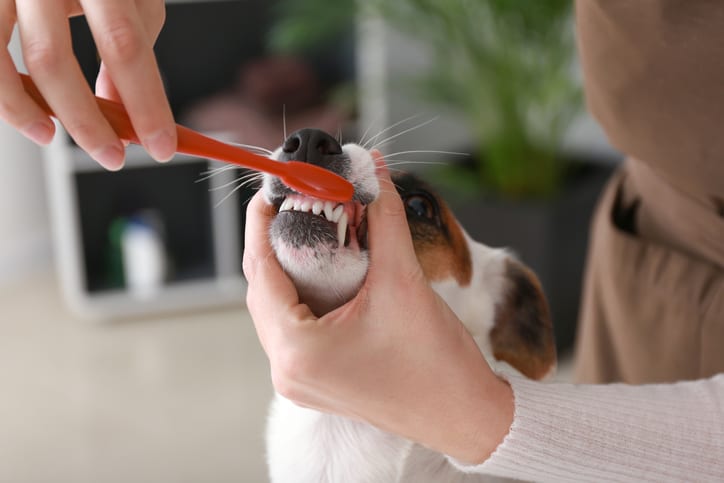Keeping your dog’s teeth clean along with oral hygiene is another aspect of your dog’s health that’s as equally important as a healthy diet and regular check-ups with your veterinarian. According to the American Veterinary Dental College (AVDC), many dogs show signs of periodontal disease by the age of three. Periodontal, or gum disease, is an infection of the tissues that hold the teeth in place. The first sign of periodontal disease is bad breath, which often goes unnoticed by owners because we expect dogs to have bad breath.
Periodontal disease can cause some serious health issues for your best friend, so it’s essential to maintain healthy oral hygiene. Just like humans, dogs experience plaque build-up, which can then turn into tartar, accumulating around the gum lines and causing irritation, gum inflammation (gingivitis), bone/soft tissue loss, abscesses, and gum disease. Bacterial infection can also lead to tooth loss and complications of the heart, lung, or kidney as your dog ages. The good news is that, with regular dental care, these diseases are preventable, and one of the best ways to keep maintain your dog’s dental health is to brush her teeth.
Why Should I Brush My Dog’s Teeth?
A dog’s mouth contains lots of bacteria, so you might want to wear gloves while brushing your dog’s teeth. If you don’t have any gloves handy, just make sure to thoroughly wash your hands with soap and water after when you’re done. Also, it’s recommended to rinse the toothbrush thoroughly before putting it away, and if possible, replace the toothbrush every three months. It’s estimated that over two-thirds of dogs over the age of three have periodontal disease (inflammation or infection of the gums and tissues surrounding the teeth). Periodontal disease starts as gingivitis, which is caused by plaque and can progress towards tooth loss.
Frequency of Brushing Your Dog’s Teeth
Like with humans, it’s ideal to brush your dog’s teeth at least twice a day. Although this may not be possible in some cases, brushing three times a week is the minimum recommendation to help fight plaque and prevent tartar formation. Once brushing becomes a part of your dog’s daily routine, she’ll begin to enjoy it. It’s best to teach your dog to accept toothbrushing while she is still a puppy, and if you have an older dog, it may take a little longer to train her, but it will be worth the effort.
Training Your Dog to Have Her Teeth Brushed
To be successful at brushing your dog’s teeth, it’s best to make it a positive experience for both of you. You can put a positive spin on brushing your dog’s teeth by praising her throughout the whole process. Below are several tips for brushing your dog’s teeth.
Start Small
First, get your dog used to the idea of having her teeth brushed. Try to keep the sessions short and non-stressful. You can acclimatize your dog to having her teeth brushed by dipping your finger in something tasty like bouillon, and massage her lips, once or twice a day for a few weeks, and then move on to the teeth and gums.
Begin Brushing
Second, apply a small amount of toothpaste to the toothbrush. Gently raise your dog’s lips on one side of her mouth (you can either do this by pushing up on the lip with the index finger of your free hand or by placing your free hand over your dog’s head with your thumb and index finger on opposite sides of your dog’s upper jaw to lift his lips). Next, place a toothbrush along with your dog’s teeth, and gently brush in small, circular motions. To brush the lower teeth, you will need to open your dog’s mouth a little. This can be done by gently tilting your dog’s head backward while holding onto his or her upper jaw with the thumb and index finger of your free hand. Try to brush vertically toward the inside of the mouth to clear any plaque and debris. Always use a toothbrush designed especially for dogs because it’s smaller than a human toothbrush and has softer bristles. You can also use toothbrushes that fit over your finger as well. Many pet owners find it easier to use a finger brush, especially when just beginning to brush their dog’s teeth. Check with your veterinarian if you are uncertain of which brush to use.
Use Dog Toothpaste
Always use toothpaste designed specifically for dogs, never use human toothpaste. Human toothpaste often contains an artificial sweetener called xylitol, which can cause acute low blood sugar levels in dogs and can cause liver damage. Dog toothpaste is available in several different flavors that are appetizing to dogs, including poultry, mint, peanut butter, and beef, and using a toothpaste that tastes good will make the experience more pleasant for your dog.
How Long Should I Spend Brushing My Dog’s Teeth?
It’s recommended to try to brush for approximately 30 seconds per side, and being careful not to brush too harshly, and to make sure you can get at the back molars. Just as with humans, try to brush all the surfaces of your dog’s teeth if possible: The incisors, canines, premolars, and molars, including the sides and occlusal surfaces (the chewing surfaces).
Contact Your Veterinarian
Brushing your dog’s teeth is the best way to keep your dog’s teeth healthy while at home. However, if you notice that your dog has very bad breath, trouble eating, excessive drooling or her mouth seems painful, call 412-373-8580 and book an appointment with your veterinarian at Northern Pike Veterinary Hospital. She may need a thorough dental exam and a professional dog teeth cleaning.


